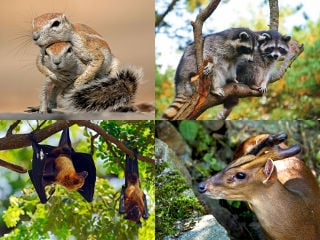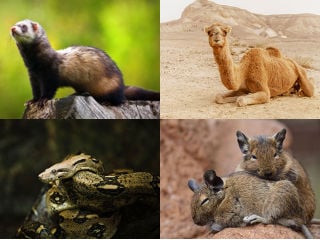Florida's wild side isn't just about beautiful beaches and palm trees - the Sunshine State is also home to some seriously dangerous creatures. From massive alligators sunbathing on golf courses to venomous snakes slithering through the underbrush, these powerful predators remind us that Florida's wilderness isn't always paradise.
When you're exploring Florida, you'll encounter all sorts of wildlife - some cute and harmless, others that deserve a healthy dose of respect and distance. Let me walk you through the top ten animals you'll want to watch out for when you're enjoying the great outdoors in Florida.
1. The alligator

Living in Florida, you quickly learn to respect alligators - these powerful predators will eat just about anything they can catch. While they're most active at night, don't let your guard down during daylight hours. These massive reptiles rank among Florida's most dangerous creatures, and it's no wonder why - they can grow to an incredible 20 feet and tip the scales at over 1,000 pounds.
These opportunistic hunters aren't picky eaters. With razor-sharp teeth and jaws strong enough to crush bone, they'll take down everything from fish and turtles to snakes and birds. And don't let their bulky appearance fool you - gators can sprint surprisingly fast when they need to, reaching speeds up to 30 mph in short bursts.
While alligator attacks on humans don't happen often, they can be lethal when they do occur. You'll find these prehistoric-looking creatures in freshwater areas across Florida - marshes, rivers, lakes, and swamps. During summer months, when the water warms up, they're especially active.
Most run-ins with humans happen when alligators are defending their territory rather than hunting for food. Still, there have been some deadly encounters over the years. If you're planning to swim in Florida's waters, always stay alert and avoid going alone. The best approach is to stick to designated swimming areas and keep your distance if you spot one.
Remember the golden rule: never approach an alligator. If you see one while you're out and about, give it plenty of space and calmly leave the area. These aren't creatures you want to mess with, no matter how tempting it might be to get a closer look.
2. The Florida panther

Coming in at number two on our list of Florida's most dangerous exotic animals is the magnificent yet deadly Florida panther. As a subspecies of the cougar, these powerful cats have seen their numbers plummet from around 500 in the early 1900s to just 160 today, making them one of North America's most critically endangered species.
These elusive predators come alive at night, prowling the darkness in search of their next meal. They're skilled hunters, taking down deer, wild hogs, and rabbits to satisfy their carnivorous appetite. Like most big cats, Florida panthers prefer the solo life, only meeting up with others when it's time to mate. Mother panthers typically raise two or three cubs for about a year before the young ones head off to establish their own territory.
While these cats generally keep their distance from humans, you definitely don't want to test your luck with one. Though attacks on people are rare, a threatened panther is no joke - these muscular cats can weigh up to 200 pounds and pack some serious power. If you're lucky (or unlucky) enough to cross paths with one, your best bet is to slowly back away without making eye contact. Local farmers know all too well about their strength, as panthers occasionally target livestock like cattle and sheep. It's this combination of power, size, and predatory instinct that earns the Florida panther its spot among the state's most dangerous creatures.
3. The black bear

Despite their name, American black bears aren't always black - they can sport coats ranging from blue-grey to cinnamon brown. These fascinating creatures, the smallest of North America's three bear species, roam throughout much of the eastern and northern parts of the continent.
Their dark fur, particularly on their backs and sides, is what earned them their common name. These bears are incredibly athletic - they're excellent swimmers and can sprint at speeds up to 35 mph. When they need to escape danger or reach tasty treats, they'll skillfully scramble up trees without hesitation.
While they mainly munch on plants, black bears aren't picky eaters. They'll happily snack on insects, fish, and small mammals, and they've been known to help themselves to beehives and unsecured garbage cans. Sometimes they'll even take down deer. Here in Florida, you'll find them primarily in the Panhandle and throughout the northern and central regions.
Although black bears typically prefer to avoid human contact, it's important to remember they're wild animals that can be dangerous if they feel threatened. If you encounter one, stay calm and slowly back away - never approach or run. In the rare case of an attack, fight back aggressively using whatever you have on hand, including your voice. The best way to avoid bear encounters is to keep your trash secured and never feed them, intentionally or unintentionally. When hiking in bear country, always give these powerful animals plenty of space.
4. The eastern diamondback rattlesnake

The Eastern diamondback rattlesnake is a beast of a serpent - in fact, it's the largest venomous snake you'll find in North America. These impressive creatures can stretch out to 8 feet long and pack on up to 10 pounds, with distinct diamond patterns across their muscular bodies. You'll spot them lurking in forests, marshlands, and swampy areas.
These aren't snakes you want to mess with. While they'd rather avoid a fight, Eastern diamondbacks won't hesitate to defend themselves if they feel cornered or threatened. Their venom is seriously powerful stuff - potent enough to be lethal to humans.
If you're in the Southeast, particularly during the warmer seasons, keep an eye out for these rattlers. They're common throughout the southern and eastern regions. Should you cross paths with one, remember to keep your cool - no sudden moves. And if you're unlucky enough to get bitten, don't wait around - head straight to the emergency room. This isn't the kind of bite you can sleep off.
5. The water moccasin

Coming in at number five on Florida's most dangerous animals list is the water moccasin, or cottonmouth as locals often call it. These powerful snakes are a regular sight if you spend time around Florida's swamps and waterways. While they'd rather avoid a fight, they won't back down if they feel cornered.
These chunky snakes are pretty impressive, stretching anywhere from 3-5 feet long. You'll recognize them by their stocky build and dark coloring, usually brown or black, with a telltale pale stripe running along their sides. Though not speed demons, they can strike with lightning quickness when they need to.
True to their name, water moccasins love hanging out near water. You'll often spot them sunbathing on logs or rocks by the water's edge, where they're perfectly positioned to grab their next meal - usually fish, frogs, or any unlucky small mammal that crosses their path.
What makes these snakes especially fascinating is their built-in heat detector - a small pit between their eyes and nostrils that works like night vision goggles, helping them track warm-blooded prey even in pitch darkness. While Florida has its share of venomous snakes, water moccasins are widely considered the ones you really don't want to mess with.
Their venom packs a serious punch and can be deadly without quick treatment. A bite will cause excruciating pain, major swelling, and can destroy tissue. In worst-case scenarios, it can even lead to paralysis and breathing problems.
The good news is that effective antivenom exists, but you definitely want to avoid getting bitten in the first place. If you're exploring areas where these snakes live, play it safe - wear sturdy boots and long pants, and think twice before splashing around in spots where they might be lurking.
6. The coral snake

Coming in at number six on our list of Florida's scariest creatures is the coral snake - a small but mighty predator that packs a serious punch. While they typically only grow to about three feet long, don't let their size fool you. These beautiful but deadly snakes can deliver a bite that could send you straight to the ER.
You'll know a coral snake when you see one, thanks to their eye-catching bands of red, yellow, and black. Remember that old saying "red touch yellow, kill a fellow"? That's your key to identifying these guys. While the exact pattern can vary, those bright warning colors are Mother Nature's way of saying "back off!"
Here's the good news: coral snakes would much rather slither away than pick a fight. They're naturally timid and do their best to avoid running into humans. But if you corner one or accidentally step on it, watch out - they won't think twice about defending themselves. Your best bet? Give them plenty of space and leave them be. Trust me, you don't want to find out firsthand why these snakes made our top ten list.
7. The Copperhead

Coming in at number seven on our list of Florida's most dangerous exotic animals is the copperhead - a venomous snake you definitely don't want to mess with. While they're pretty common throughout the Southeast, including here in Florida, these pit vipers are easily recognized by their distinctive copper-colored heads.
Your average copperhead stretches about three feet long, sporting a mix of brown or tan scales with darker crossbands. While they're not out looking for trouble - actually, they're pretty shy creatures - you'll want to watch your step. These snakes prefer to avoid confrontation, but they won't hesitate to strike if they feel cornered or threatened.
If you happen to cross paths with a copperhead while out on a trail or in your yard, the best move is to give it plenty of space and let it go about its business. Their bite packs a serious punch, and it's just not worth the risk of getting too close.
8. The Great White Shark

Coming in at number eight on Florida's most dangerous animals is the notorious great white shark - and yes, there's a good reason these predators strike fear into the hearts of beachgoers everywhere.
These ocean giants are seriously impressive. Picture a shark the length of a small yacht - up to 20 feet long - and weighing as much as two cars combined at 5,000 pounds. Their teeth are like rows of serrated knives, and their sense of smell is so incredible they can detect a single drop of blood from a mile away in the ocean.
While great whites roam all the world's major oceans, they're most commonly spotted off the coasts of Australia, South Africa, and California. Here in Florida, you're most likely to encounter them near Palm Beach and Daytona Beach.
But here's the thing - as scary as great whites might be, they're actually not Florida's biggest shark threat. That honor belongs to the bull shark. Though smaller, bull sharks are more aggressive and hang out in much shallower water, making them a bigger concern for swimmers and surfers. If you're hitting Florida's beaches, keep your eyes peeled and stay alert - it's always better to be safe than sorry when sharing the water with these powerful predators.
9. The Barracuda

These impressive predators can stretch up to six feet long and love hanging around coral reefs, sunken ships, and other underwater hideouts. Like most ocean hunters, they'll eat whatever they can catch - usually smaller fish, but they won't turn down squid or crustaceans if they're hungry.
While barracudas aren't out to get humans, they can get a bit too curious for comfort, especially if something shiny catches their eye. That sparkly watch or diving knife might look like their next meal, which can lead to trouble. If you're unlucky enough to get bitten by one, don't tough it out - get to a doctor right away.
Look, barracudas might seem scary, but they're not the ocean's bad guys. Sure, they can do some damage if things go wrong, but they're not actively hunting humans like some folks think. Still, it's just common sense to keep your wits about you when you're in their territory - just like you would with any wild animal.
10. The Jellyfish

Jellyfish are fascinating but potentially dangerous creatures that frequently show up in Florida's waters. While they might look peaceful floating through the ocean, these gelatinous animals can pack quite a punch. Some are nearly invisible in the water, while others catch your eye with stunning colors or even their own natural glow.
Most jellyfish you'll encounter aren't out to get you, but their tentacles can deliver a nasty surprise if you accidentally brush against them. How bad a sting feels really depends on which type of jellyfish you meet - some just leave you with an annoying burn, while others can put you in serious danger. It also matters how big the jellyfish is and how sensitive your body is to their sting.
The real troublemakers to watch out for are the box jellyfish, Portuguese man of war, and Irukandji jellyfish. These aren't your average jellyfish - their stings can cause serious problems like paralysis and heart issues, and in rare cases, they can even be deadly.
If you're swimming in Florida's waters, especially during jellyfish season, keep your eyes peeled. Look for warning flags on the beach and pay attention to local reports about jellyfish activity. If you do get stung, don't try to tough it out - get medical help right away.
Florida's beautiful waters come with their share of risks. Along with jellyfish, there are plenty of other creatures you'll want to steer clear of. Being informed and knowing how to handle an encounter can make the difference between a great beach day and a trip to the emergency room.
Here are the top five things you can do to protect yourself from the dangerous animals in Florida:
FAQ
What florida animals are endangered?
Florida is home to a diverse array of wildlife, and unfortunately, many of its native species are at risk of extinction due to habitat loss, climate change, pollution, and other threats. Here are some of the endangered animals in Florida:
Florida Panther, West Indian Manatee, North Atlantic Right Whale, Red Wolf, Key Deer, Florida Grasshopper Sparrow, Leatherback Sea Turtle
What animal in florida sounds like a monkey?
Common Loon (Gavia immer). The loon's calls and yodels can sound similar to the vocalizations of some primates and have been described as monkey-like. However, the Common Loon is a bird species and is not related to primates.






